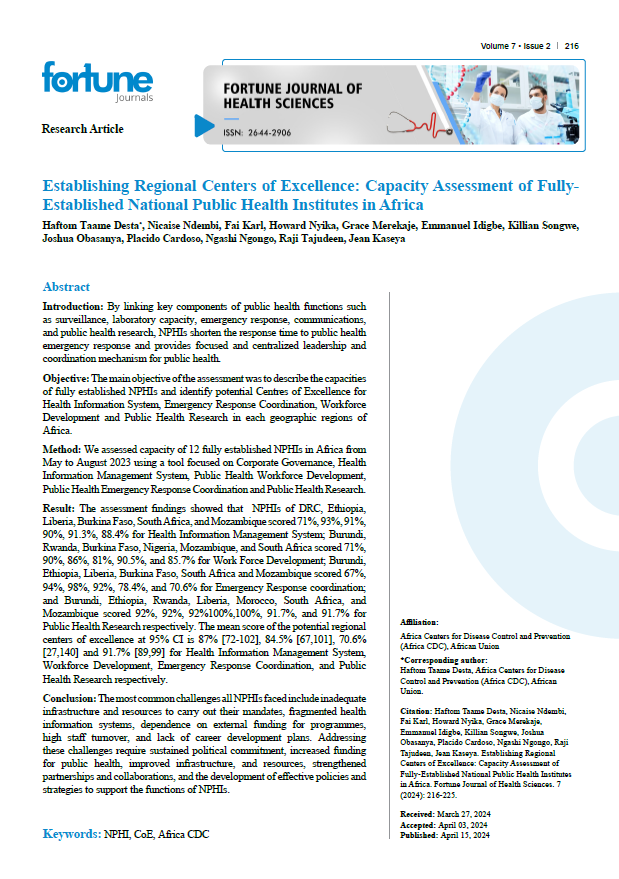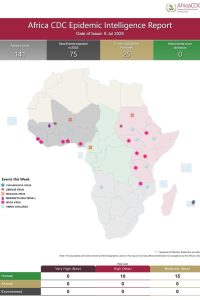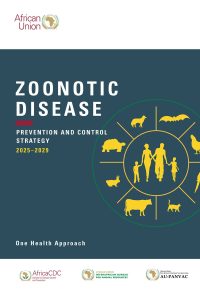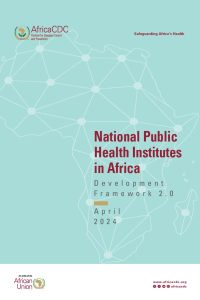
- Version
- Download 2201
- File Size 471.37 KB
- File Count 1
- Create Date 2 May 2024
- Last Updated 2 May 2024
Establishing Regional Centers of Excellence: Capacity Assessment of Fully-Established National Public Health Institutes in Africa
Haftom Taame Desta*, Nicaise Ndembi, Fai Karl, Howard Nyika, Grace Merekaje, Emmanuel Idigbe, Killian Songwe, Joshua Obasanya, Placido Cardoso, Ngashi Ngongo, Raji Tajudeen, Jean Kaseya
Africa Centers for Disease Control and Prevention (Africa CDC), African Union
Abstract
Introduction: By linking key components of public health functions such as surveillance, laboratory capacity, emergency response, communications, and public health research, NPHIs shorten the response time to public health emergency response and provides focused and centralized leadership and coordination mechanism for public health.
Objective: The main objective of the assessment was to describe the capacities of fully established NPHIs and identify potential Centres of Excellence for Health Information System, Emergency Response Coordination, Workforce Development and Public Health Research in each geographic regions of Africa.
Method: We assessed capacity of 12 fully established NPHIs in Africa from May to August 2023 using a tool focused on Corporate Governance, Health Information Management System, Public Health Workforce Development, Public Health Emergency Response Coordination and Public Health Research.
Result: The assessment findings showed that NPHIs of DRC, Ethiopia, Liberia, Burkina Faso, South Africa, and Mozambique scored 71%, 93%, 91%, 90%, 91.3%, 88.4% for Health Information Management System; Burundi, Rwanda, Burkina Faso, Nigeria, Mozambique, and South Africa scored 71%, 90%, 86%, 81%, 90.5%, and 85.7% for Work Force Development; Burundi, Ethiopia, Liberia, Burkina Faso, South Africa and Mozambique scored 67%, 94%, 98%, 92%, 78.4%, and 70.6% for Emergency Response coordination; and Burundi, Ethiopia, Rwanda, Liberia, Morocco, South Africa, and Mozambique scored 92%, 92%, 92%100%,100%, 91.7%, and 91.7% for Public Health Research respectively. The mean score of the potential regional centers of excellence at 95% CI is 87% [72-102], 84.5% [67,101], 70.6% [27,140] and 91.7% [89,99] for Health Information Management System, Workforce Development, Emergency Response Coordination, and Public Health Research respectively.
Conclusion: The most common challenges all NPHIs faced include inadequate infrastructure and resources to carry out their mandates, fragmented health information systems, dependence on external funding for programmes, high staff turnover, and lack of career development plans. Addressing these challenges require sustained political commitment, increased funding for public health, improved infrastructure, and resources, strengthened partnerships and collaborations, and the development of effective policies and strategies to support the functions of NPHIs.
More at https://www.fortunejournals.com/articles/establishing-regional-centers-of-excellence-capacity-assessment-of-fullyestablished-national-public-health-institutes-in-africa.html
Attached Files
| File | Action |
|---|---|
| Establishing Regional Centers of Excellence: Capacity Assessment of Fully-Established National Public Health Institutes in Africa | Download |






